Horseshoe kidney
| Horseshoe kidney | |
|---|---|
 | |
| Horseshoe kidney | |
| Classification and external resources | |
| Specialty | medical genetics |
| ICD-10 | Q63.1 |
| ICD-9-CM | 753.3 |
| DiseasesDB | 6020 |
| eMedicine | article/441510 article/378396 |
Horseshoe kidney, also known as ren arcuatus (in Latin), renal fusion or super kidney, is a congenital disorder affecting about 1 in 600 people, more common in men.[1]
In this disorder, the patient's kidneys fuse together to form a horseshoe-shape during development in the womb. The fused part is the isthmus of the horseshoe kidney.
Fusion abnormalities of the kidney can be categorized into two groups: horseshoe kidney and crossed fused ectopia. The 'horseshoe kidney' is the most common renal fusion anomaly.
Signs and symptoms

In patients with this condition, the central portion of the kidney may be found just inferior to the inferior mesenteric artery because the normal embryologic ascent of the kidneys is arrested by its presence in people with central fusion of the kidneys.[2] Horseshoe kidney is often asymptomatic, though persons affected by this condition may experience nausea, abdominal discomfort, kidney stones and urinary tract infections at greater frequency than those without renal fusion. There is currently no treatment for renal fusion other than symptomatic treatment.
Imaging Findings - The 2 kidneys on opposite sides of the body with the lower poles fused in midline. Midline or symmetrical fusion (90% of cases). May be missed on US, therefore pay careful attention to identification of lower poles of kidneys. Renal long axis medially orientated, Lower poles with curved configuration, elongation and poorly defined Isthmus crosses midline anterior to spine and great vessels. US for diagnosis in utero IVP followed by CT or scintigraphy for pre-operative assessment
Variant arterial supply - Bilateral renal arteries, Inferior mesenteric Artery, Arteries arising from aorta or common iliac, internal iliac, external iliac or inferior mesenteric arteries.
The lower poles of these kidneys fuse in the midline anterior to the aorta and spine. The isthmus is usually located at L4/5 level between the aorta and IMA.
Nuclear medicine (DMSA) scan confirms horseshoe kidney with fusion of both renal lower poles.
Associated conditions

While most cases of horseshoe kidneys are asymptomatic and discovered upon autopsy, the condition may increase the risk for:
- Kidney obstruction – abnormal placement of ureter may lead to obstruction and dilation of the kidney.
- Kidney infections – associated with vesicoureteral reflux.
- Kidney stones – deviant orientation of kidneys combined with slow urine flow and kidney obstruction may lead to kidney stones.
- Kidney cancer – increased risk of renal cancer, especially Wilms' tumor, transitional cell carcinoma, and an occasional case report of carcinoid tumor.[3] Despite increased risk, the overall risk is still relatively low.
The prevalence of horseshoe kidneys in females with Turner Syndrome is about 15%.[4]
It can be associated with trisomy 18.[5]
It can be associated with venous anomalies like left sided IVC 9.[6]
Notable cases
- Mel Gibson is affected with this condition.[7]
- Sam Kinison, an American comedian, also had this condition.[8]
- Robert Rowan, the former Archdeacon of Ardfert[6]
References
- ↑ Gupta M, Pandey AK, Goyal N (2007). "Horseshoe kidney--a case report". Nepal Medical College Journal. 9 (1): 63–6. PMID 17593682.
- ↑ Oktem H, Gozil R, Calguner E, Bahcelioglu M, Mutlu S, Kurkcuoglu A, Yucel D, Senol E, Babus T, Kadioglu D (2008). "Morphometric study of a horseshoe kidney". Medical Principles and Practice. 17 (1): 80–3. PMID 18059107. doi:10.1159/000109596.
- ↑ de Hoog JP, Murray S and Chou W (2010). Horseshoe kidney and primary renal carcinoid tumour: a case report of a rare entity. Grand Rounds 10 46–50 grandrounds-e-med.com Archived 2011-07-11 at the Wayback Machine.
- ↑ Kleta R, Brämswig JH (2000). "Horseshoe kidney and Turner syndrome". Nephrol. Dial. Transplant. 15 (7): 1094. PMID 10862660. doi:10.1093/ndt/15.7.1094-b.
- ↑ "Renal Pathology". Retrieved 2008-11-26.
- 1 2 Khandelwal A, Gupta P, Gupta A (2012). "Left-sided inferior vena cava in horseshoe kidney: an unusual anomaly". Iranian Journal of Kidney Diseases. 6 (1): 17. PMID 22218114.
- ↑ https://www.youtube.com/watch?v=eTMwsUHmufA%5B%5D
- ↑ http://www.autopsyfiles.org%5B%5D